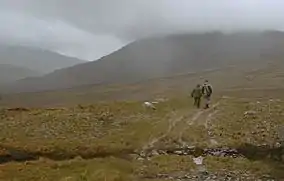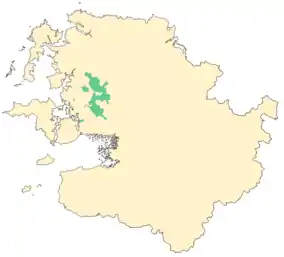Ballycroy National Park
Ballycroy National Park (Irish: Páirc Náisiúnta Bhaile Chruaich) is located in the Owenduff/Nephin Mountains area of the Barony of Erris in northwest County Mayo, Ireland. It is one of the largest expanses of peatland in Europe, consisting of 117.79 square kilometres of Atlantic blanket bog. It is a unique habitat with a diverse flora and fauna. It was established as a national park on 1 November 1998.[1] The area of the park is a candidate Special Area of Conservation (cSAC) as part of a site known as the Owenduff/Nephin Complex. It is also a Special Protection Area and part of the Natura 2000 network.[2] [3]
| Ballycroy National Park | |
|---|---|
IUCN category II (national park) | |
 The Bangor Way, in the Nephin Beg Mountains | |
 Map of Ballycroy (Green) within County Mayo | |
| Location | County Mayo, Ireland |
| Area | 11,779 ha |
| Established | 1998[1] |
| Governing body | National Parks and Wildlife Service |
Establishment of Ballycroy National Park
The European Union Habitats Directive (92/43/EEC), which was transposed into Irish law in 1997, lists certain habitats and species that the Irish Government was required to designate as SACs to ensure their protection. These habitats include blanket bogs.[3] The bog at Ballycroy is especially important in this regard because it is one of the largest examples of a blanket bog habitat left in Western Europe. Ballycroy was established as a national park on 1 November 1998. It is managed under the State Property Act of 1954.[1]
Features of Ballycroy National Park
Blanket bogs, cliffs and river habitats are found in the park. The blanket bog is one of the largest expanses of peatland left in Europe. Conservation of the bog is thus of international importance because of the niches it provides for various species, such as rare species of plants. The Owenduff River is also an important conservation area because it is the only river in Western Europe that still drains a relatively intact and extensive blanket bog system. It is also a very prolific salmon and sea trout river.[1]
The Owenduff area is an important roosting, feeding and breeding site for a number of migratory bird species, such as the Greenland white-fronted goose, that are protected by the European Union Birds Directive.[1] Other rare species found in the park include the whooper swan, peregrine falcon and corncrake.[3]
A visitor centre for the park opened in 2009. The 700 square meter building overlooks the Atlantic Ocean in Ballycroy village. It opens daily throughout the summer tourist season.[4]
Expansion: "Wild Nephin"
In 2017, 4,000 hectares of conifer forest and mountain controlled by Coillte was added to the 11,000 hectares of the adjoining Ballycroy National Park. The area is to be managed by the National Parks and Wildlife Service (NPWS) and has been identified as having potential for rewilding.[5] The area was originally an industrial forest, consisting of pine and spruce plantations, with logging roads throughout.[6]
References
- "National Parks and Wildlife Service". Archived from the original on 2006-08-14. Retrieved 2006-07-28.
- CONSERVATION OF WILD BIRDS (OWENDUFF/NEPHIN COMPLEX SPA 004098)
- "Mayo County Council — Natural Heritage". Retrieved 2006-07-28.
- "Irish government press release". Retrieved 2006-07-28.
- Viney, Michael. "Wild Nephin". Irish Times. Retrieved 2018-01-19.
- Antonelli, Lenny (July–August 2014). "Those Not-So-Wild Europeans". Sierra Club. Retrieved 2020-07-02.
